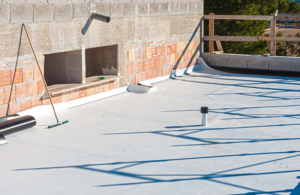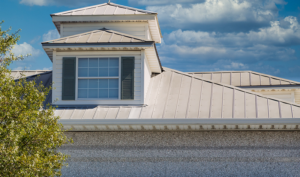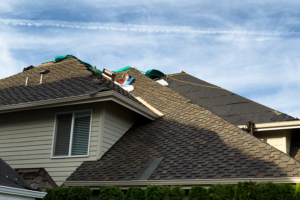Data from the National Fire Prevention Association (NFPA) during 2007-2011 shows that U.S. fire departments responded to an average of 22,600 fires per year started by lightning. Of these, 19% occurred in homes, and another 7% involved businesses and non-residential buildings. When lightning strikes, it doesn’t matter if the materials it hits can conduct electricity or not. If the roof is covered with combustible materials such as wood shakes or extremely flammable asphalt shingles, they are easily ignited as it channels through to the ground via the house’s pipes and electrical system. Fire is the most severe risk of a lightning strike to your home. Lightning can spread in the attic and within the walls after jumping from the roof, seeking the most conductive path to the ground. In addition to structural damage, your home can experience a surge of electrical current through water pipes, phone lines, and electrical outlets that impact devices such as a television, electrical appliances, landline or corded phones, cordless phone chargers, computers, and other expensive electronics.
When studying lighting strikes and home damage there are a significant number of factors to take into account when preparing your home. It is important to factor all of the risks involved in your specific properties location and build. Check out this list.
Building Height And Surface Area
Electrical charge builds on the highest object in the area, so buildings on elevated sites such as hilltops have an increased probability of strikes. Tall buildings with high roof points have a greater risk of lighting strike than a flat roof low profile building.
A direct lightning strike is most likely on the strike zone’s highest point, so the tallest building has the highest lightning strike risk relative to any nearby structures. Conversely, the smaller buildings in the area enjoy some protection and have reduced risk. Large buildings with more roof surface area provide a larger surface for a direct lightning strike.
Geographic Region
Thunderstorm frequency varies from region to region, with an average of 100,000 in the U.S. alone. About 10% of those reach “severe” status and can cause storms that can significantly damage your home. In general all regions of the U.S. experience lighting storms, but they are usually the most destructive during spring and summer squalls and severe thunderstorms.
Lightning Strike Damage
A strike can cause damage to your property in several ways. A power surge can damage your electronics and home appliances if it flows to the ground via your home’s electrical wiring. If lightning strikes your home’s electrical wiring, your power will go out. While not protecting from a direct hit, surge protectors can protect from lightning damage, particularly the UPS type.
Second, a lightning bolt that passes through your home is incredibly hot and can set materials like roof shingles, trusses, and insulation on fire. House fires do occur, and they can cause a considerable amount of damage.
The shock wave of a lightning strike can also damage your roof by breaking off chimney bricks or shingles. Your gutters may even come loose or tear away from the house, and doors and windows can be damaged.
Lightning strikes on metal roofs are an understandable concern for homeowners considering an upgrade to a metal roof. However, research on lightning protection shows that metal roofing is no more likely to attract a strike than any other type of conventional roofing material. In fact, as a non-combustible material with a Class A fire-resistance rating, metal roofing is the most desirable material for homes and businesses in lightning-prone regions.
There are three main ways lightning can get inside your house. The most common is through a direct strike on the structure. The other two ways it can enter your home are through the ground and through pipes or wires extending outside your house.
Shock Wave Damage
A crashing boom of thunder is the signature explosive shock wave of lightning. At the closest range during a strike, those shock waves can be highly destructive with enough force to fracture concrete, brick chimneys, cinderblock, and stone. After a storm has passed, it’s a good idea to walk the grounds and look for smoke, water leaks, potential damage to structural material as well as electronic devices, and check your insurance policy.
Lightning rods
Lightning is an electrical charge that follows the path of least resistance to the ground. A solution to having more control over where it will strike is to provide a better secondary route to the ground. Residential lightning protection systems, or lightning rods, offer a low-resistance, highly efficient method for passing the lightning current and voltage from a strike down to the ground rod that is away from your roof materials. When all three of these materials offer low resistance, the electrical charge will follow it, and the current passing through the connector cable won’t jump or damage your home. A quality rod system can help you avoid fires, roof damage, and other significant problems that can happen from a lightning strike.
Clear Away Tree Branches & Debris
Tall trees need to be regularly trimmed back and kept well clear from your rooftop. Lightning strikes trees, especially when surface water significantly lowers their otherwise high resistance. It’s extremely common for strikes to cause large branches and portions to break off from a tree and fall on your roof, causing serious damage during severe weather.
RESOURCES
Blue Nail Roofing has a Master Elite contractor status awarded by the largest roofing manufacturer in North America, GAF. Only 2% of contractors in the U.S. meet the rigorous standards to achieve this status, which means you can be assured you are making a good choice when you select the professionals at Blue Nail to execute your home and business roofing repairs. Call today to schedule a professional evaluation!
Copyright © 2020 Blue Nail Enterprises. All rights reserved. | Privacy Policy
Let Us Nail Your Project! Send us a little information about your roofing or home improvement needs and an expert will reach out shortly.







